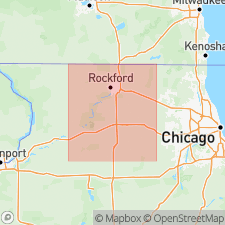
- Usage in publication:
-
- Herbert Till Member
- Modifications:
-
- Named
- Dominant lithology:
-
- Till
- AAPG geologic province:
-
- Wisconsin arch
Summary:
The recognition that the Esmond Till is a member of the Glasford Formation (Illinoian) rather than of the Wedron Formation (Wisconsinan), has left three unnamed till members below the Esmond. The oldest of these is here named the Herbert Till Member of the Glasford Formation in the subsurface of parts of Boone, De Kalb, Ogle, McHenry, and Kane Counties, IL. It consists of a gray-brown loam to sandy loam diamicton, with a clay-mineral composition similar to the Esmond, but illite often exceeds 80%. Overlies shale of the Maquoketa Group; underlies the Fairdale or Oregon Till Members of the Glasford Formation. It was previously correlated with the Sterling Till Member of the Glasford. Thickness is less than 10 m. Age is Pleistocene (Illinoian).
Source: GNU records (USGS DDS-6; Reston GNULEX).
For more information, please contact Nancy Stamm, Geologic Names Committee Secretary.
Asterisk (*) indicates published by U.S. Geological Survey authors.
"No current usage" (†) implies that a name has been abandoned or has fallen into disuse. Former usage and, if known, replacement name given in parentheses ( ).
Slash (/) indicates name conflicts with nomenclatural guidelines (CSN, 1933; ACSN, 1961, 1970; NACSN, 1983, 2005, 2021). May be explained within brackets ([ ]).

